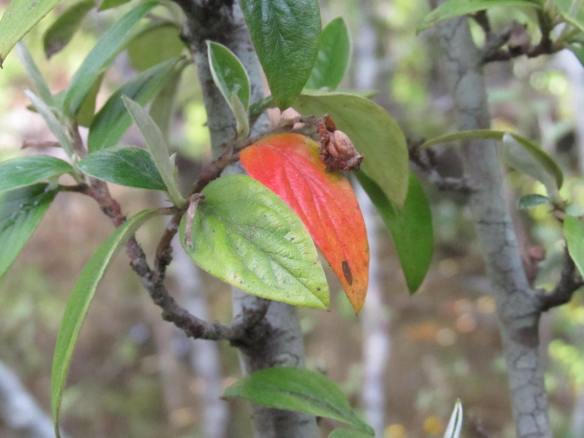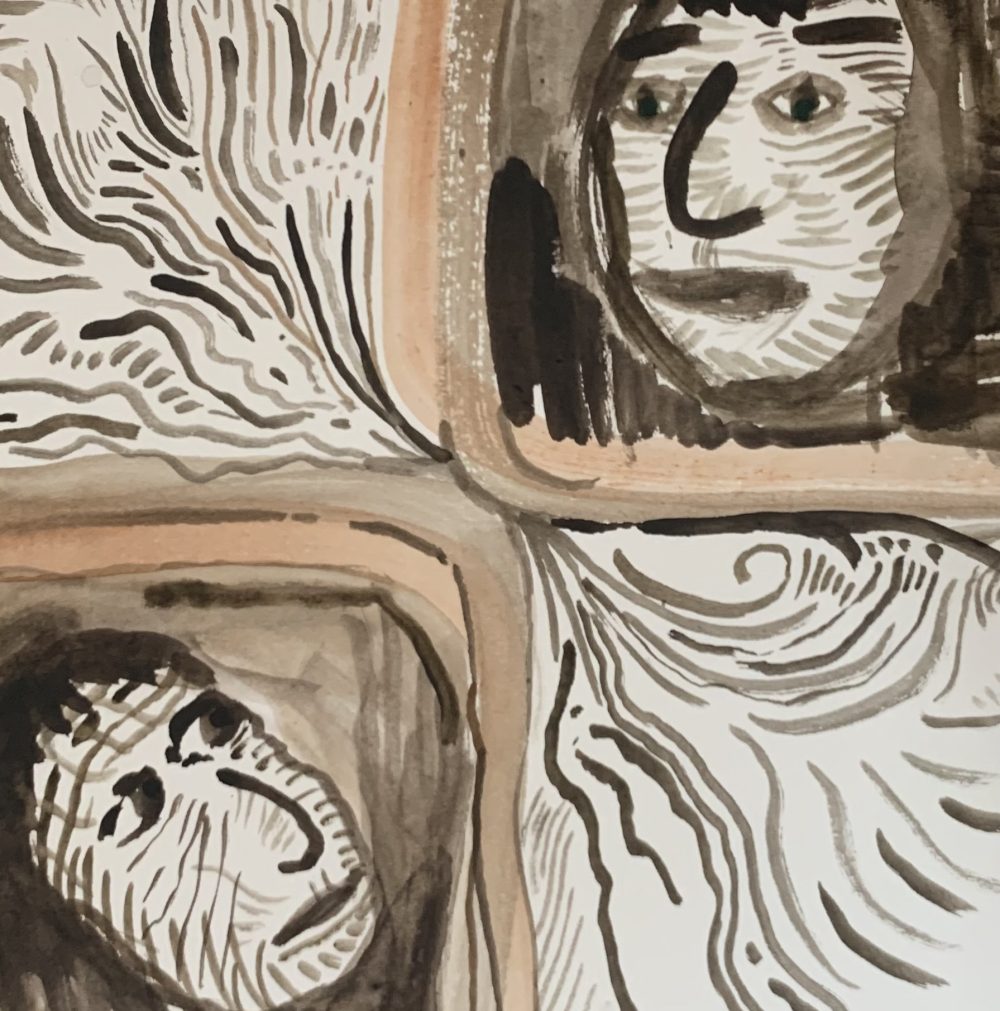 My favourite Arbutus tree was doing her usual backbend into the Colquitz River, her waxy leaves dipping into the brown flow. On my visit yesterday, I leaned into her, as I always do, feeling the cool papery bark under my bare arms and thighs. It’s dry, high summer, and the river is low and sludgy. I walk a little way down the path toward the water and crouch in a sunny spot surrounded by white umbrellas of Queen Anne’s Lace swaying in the slight breeze. The drone of bees. As I gaze at the river, a movement on the opposite bank catches my eye. A mother raccoon with four kits emerges from the undergrowth. The kits follow her lead and stand in the shallows, “washing” their paws in the brown liquid. A sound between a cat’s purr and bird-song chirrups from the large female as she guides the kits along the bank, batting one occasionally when it pauses too long in the water. The creatures disappear quickly back into the hedges and I am left watching the treacly river wend its lazy way.
My favourite Arbutus tree was doing her usual backbend into the Colquitz River, her waxy leaves dipping into the brown flow. On my visit yesterday, I leaned into her, as I always do, feeling the cool papery bark under my bare arms and thighs. It’s dry, high summer, and the river is low and sludgy. I walk a little way down the path toward the water and crouch in a sunny spot surrounded by white umbrellas of Queen Anne’s Lace swaying in the slight breeze. The drone of bees. As I gaze at the river, a movement on the opposite bank catches my eye. A mother raccoon with four kits emerges from the undergrowth. The kits follow her lead and stand in the shallows, “washing” their paws in the brown liquid. A sound between a cat’s purr and bird-song chirrups from the large female as she guides the kits along the bank, batting one occasionally when it pauses too long in the water. The creatures disappear quickly back into the hedges and I am left watching the treacly river wend its lazy way.
I walk along the trail 20 metres or so and as I come into a clearing, watch a substantial bird—perhaps the size of a big robin—feeding on the ground. Noticing me, he flies rapidly into a tree and I approach softly, cautiously, to get a better look. He looks like a male Northern Flicker, a scarlet slash on his throat. I am so close I can see the handsome beige plumage on his breast, speckled with dark brown, like flax seeds in bread.
Today, during my walk around the horticulture gardens, I rounded a corner and came upon a California quail, several chicks scuttling behind her. I admire their developing “topknots,” still tiny compared to their mother’s larger plume of dark feathers atop her head. A few minutes later, I happen upon a hare, still as a statue, on the meadow path. I freeze along with him and study his handsome tweed coat, his tall, swanky ears.
When I saw these animals, I was spacious awareness, a nobody. It felt like a gift I’d been given, to quietly witness their everyday existence on the river, in the tree, in the meadow. I started to think about how I’ve been seeing things, observing, letting my “self” recede so I am a container of consciousness, a watcher. It hasn’t always been so. Reading my old journals as I attempt to write my memoir has made me see a pattern in my life: My yearning to be seen shows up over and over again. Engulfed by that obsession to be validated, I was often oblivious to seeing what was happening around me. Analogous to the logic of Maslow’s hierarchy, I had to be seen before I could see.
Why does being seen by another feel so primordial, so necessary, so life giving? Ralph Ellison, in his masterpiece, Invisible Man, was able to convey that sense of not being seen—of the eyes of the interlocutor passing over you as if glazing off the skin’s surface without taking in the who-ness of the other. He is invisible to everyone he meets because they see only the stereotype of black man; he is a carapace, a skin without substance. Nobody sees who he really is. That is an awkward identification—who am I to compare myself to the oppressed African American man? But the idea holds. It was about not been recognized, not being looked at deeply with understanding and recognition. About the hungry, emerging identity, looking for a reflection to hook into. Who am I? The other, the mother, does not mirror back who I am—and my own recognition that I might have missed something crucial in childhood: the mixed comfort and power derived from the mother’s mirroring eyes.
When I come across girls in novels and autobiographies who were not seen by their mothers, I realize that I am looking at a kind of fundamental misrecognition. Didn’t John Bowlby—king of attachment theory—tell us that babies need their own reflections gazing back at them from their mothers’ loving eyes to build identity? And doesn’t this ring true in so many ways?
Judith Duerk tells us that the mother is the “first representative of the Self to the infant, [and] constellates in the infant what will become the sense of Self within as the child grows.” She goes on to paint that image of loving reflection that almost makes me salivate, it sounds so delicious and so unattainable: “As the baby sees itself mirrored in the face of the mother, sees its own image lovingly reflected in the mother’s eyes, a fledgling sense of a true and worthy self is born within the infant. With the birth of that sense of self is born a sense of being seen, recognized, and valued as who one really is” (10).
Kathryn Harrison’s shocking 1997 memoir The Kiss, in which she describes her “love affair” with her father—paints a portrait of the other kind of mother – the opposite to Duerk’s ideal mirroring mother. This mother demands a certain kind of image from the child; rather than reflecting back what is, she reflects back what ought to be. Harrison gets 100% on a French test at age seven: “My mother’s excitement over my perfect score is devastating. She hugs me, she kisses me, she buys me gifts; and even at the age of seven I understand how damning is my success—that my mother’s love for me (like her mother’s for her) depends on my capitulation. She will accept, acknowledge, seeme only in as much as I will make myself the child who pleases her” (20). But the test was won by cheating, and when the child admits this, her infuriated mother drives her to her grandparents’ house and abandons her there. Harrison next comes down with a sudden, mysterious illness. She loses weight and becomes very pale. When she returns to school, everyone says “She’s a different child!” (21). And she is never quite the same; she has learned the lesson so many children of self-absorbed mothers must learn—I am only seen when I conform to what you want to see; I am only loved when I do what you want me to do. Alice Miller, in The Drama of the Gifted Child (1979) explicated this truth in its brutality, from the point of view of the child.
The crux of Harrison’s true tale is that, as a young woman, she is seduced by her father and engages in a relationship with him over several years. Not being properly seen by her mother embedded a ravenous hunger for recognition deep into the fibers of her being. He told her she was the most beautiful woman in the world, the smartest, the best. She felt seen. Her hunger was temporarily fed.
I am not suggesting that that hunger to be seen will drive all “invisible” men and women into destructive embraces. But Duerk articulates not being seen as an identity crisis: “Loss of the personal mother may leave the child without sense of self or self-worth, without hope that one will ever be seen as oneself. There is fear of being unable to become one’s true self, of never being truly known – never knowing who one truly is” (10).
If a tree falls in a forest and there’s nobody there to hear . . . does it make a sound? I need you to confirm my existence, or else I am invisible. I am persuaded by Alain de Botton’s description of love as “I”-Confirmation: “Perhaps it is true that we do not really exist until there is someone there to see us existing, we cannot properly speak until there is someone there who can understand what we are saying, in essence, we are not wholly alive until we are loved” (108). While Botton was describing this coming alive in the context of romantic love, it goes back, again, to the birthing of consciousness, to the baby’s awareness of the other, to the mother’s mirroring, loving eyes conferring “you-ness,” unique identity, to her child.
My journals record most of a lifetime searching for recognition in the eyes of others. I have prioritized been seen over seeing. But in the last decade or so there has been a shift. I feel seen now. I feel loved. And this frees me to see the world around me. Daily meditation has trained my mind so the flow of discursiveness is interrupted for longer periods, holding a space for seeing. Finally, growing older means a gradual receding of the noisy self. The ego occasionally takes a nap. I gain the ability to listen more than talk. I start to treasure invisibility because it allows me to witness the wild animals and to feel the wild joy of being nobody.

References
Bowlby, John. Attachment and Loss.New York: Basic Books, 1969.
De Botton, Alain. Essays in Love.London: Picador, 1993.
Duerk, Judith. Circle of Stones: Woman’s Journey to Herself. San Diego CA: LuraMedia, 1989.
Ellison, Ralph. Invisible Man. New York: Random House, 1952.
Harris, Kathryn. The Kiss. New York: Random House, 1997.
Miller, Alice, The Drama of the Gifted Child: The Search for the True Self. New York: Basic Books, 1997.

Beautiful essay Madeline. xxxx
On Mon, Jul 30, 2018 at 3:24 PM, Madeline Ruth Walker wrote:
> maddyruthwalker posted: “My favourite Arbutus tree was doing her usual > backbend into the Colquitz River, her waxy leaves dipping into the brown > flow. On my visit yesterday, I leaned into her, as I always do, feeling the > cool papery bark under my bare arms and thighs. It’s dry, h” >
LikeLike
Thank you so much Allison, and thanks for reading at a busy time. xo
LikeLike
🙏👍🕉☯️
LikeLiked by 1 person
Thank you Arnie for reading this old post. I re-read it and I like it too!
LikeLike